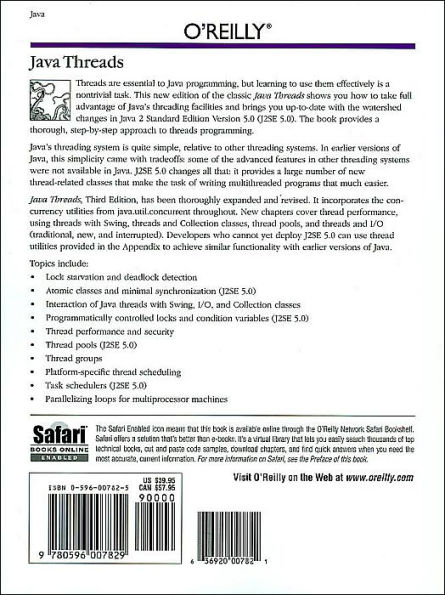Java Threads: Understanding and Mastering Concurrent Programming
Threads are essential to Java programming, but learning to use them effectively is a nontrivial task. This new edition of the classic Java Threads shows you how to take full advantage of Java's threading facilities and brings you up-to-date with the watershed changes in Java 2 Standard Edition version 5.0 (J2SE 5.0). It provides a thorough, step-by-step approach to threads programming. Java's threading system is simple relative to other threading systems. In earlier versions of Java, this simplicity came with tradeoffs: some of the advanced features in other threading systems were not available in Java. J2SE 5.0 changes all that: it provides a large number of new thread-related classes that make the task of writing multithreaded programs that much easier. You'll learn where to use threads to increase efficiency, how to use them effectively, and how to avoid common mistakes. This book discusses problems like deadlock, race conditions, and starvation in detail, helping you to write code without hidden bugs. Java Threads, Third Edition, has been thoroughly expanded and revised. It incorporates the concurrency utilities from java.util.concurrent throughout. New chapters cover thread performance, using threads with Swing, threads and Collection classes, thread pools, and threads and I/O (traditional, new, and interrupted). Developers who cannot yet deploy J2SE 5.0 can use thread utilities provided in the Appendix to achieve similar functionality with earlier versions of Java. Topics include:
1140203199
- Lock starvation and deadlock detection
- Atomic classes and minimal synchronization (J2SE 5.0)
- Interaction of Java threads with Swing, I/O, and Collection classes
- Programmatically controlled locks and condition variables (J2SE 5.0)
- Thread performance and security
- Thread pools (J2SE 5.0)
- Thread groups
- Platform-specific thread scheduling
- Task schedulers (J2SE 5.0)
- Parallelizing loops for multiprocessor machines
Java Threads: Understanding and Mastering Concurrent Programming
Threads are essential to Java programming, but learning to use them effectively is a nontrivial task. This new edition of the classic Java Threads shows you how to take full advantage of Java's threading facilities and brings you up-to-date with the watershed changes in Java 2 Standard Edition version 5.0 (J2SE 5.0). It provides a thorough, step-by-step approach to threads programming. Java's threading system is simple relative to other threading systems. In earlier versions of Java, this simplicity came with tradeoffs: some of the advanced features in other threading systems were not available in Java. J2SE 5.0 changes all that: it provides a large number of new thread-related classes that make the task of writing multithreaded programs that much easier. You'll learn where to use threads to increase efficiency, how to use them effectively, and how to avoid common mistakes. This book discusses problems like deadlock, race conditions, and starvation in detail, helping you to write code without hidden bugs. Java Threads, Third Edition, has been thoroughly expanded and revised. It incorporates the concurrency utilities from java.util.concurrent throughout. New chapters cover thread performance, using threads with Swing, threads and Collection classes, thread pools, and threads and I/O (traditional, new, and interrupted). Developers who cannot yet deploy J2SE 5.0 can use thread utilities provided in the Appendix to achieve similar functionality with earlier versions of Java. Topics include:
- Lock starvation and deadlock detection
- Atomic classes and minimal synchronization (J2SE 5.0)
- Interaction of Java threads with Swing, I/O, and Collection classes
- Programmatically controlled locks and condition variables (J2SE 5.0)
- Thread performance and security
- Thread pools (J2SE 5.0)
- Thread groups
- Platform-specific thread scheduling
- Task schedulers (J2SE 5.0)
- Parallelizing loops for multiprocessor machines
39.95
In Stock
5
1

Java Threads: Understanding and Mastering Concurrent Programming
358
Java Threads: Understanding and Mastering Concurrent Programming
358Paperback(Third Edition)
$39.95
39.95
In Stock

Product Details
| ISBN-13: | 9780596007829 |
|---|---|
| Publisher: | O'Reilly Media, Incorporated |
| Publication date: | 09/28/2004 |
| Edition description: | Third Edition |
| Pages: | 358 |
| Product dimensions: | 7.00(w) x 9.19(h) x 0.90(d) |
About the Author
From the B&N Reads Blog



